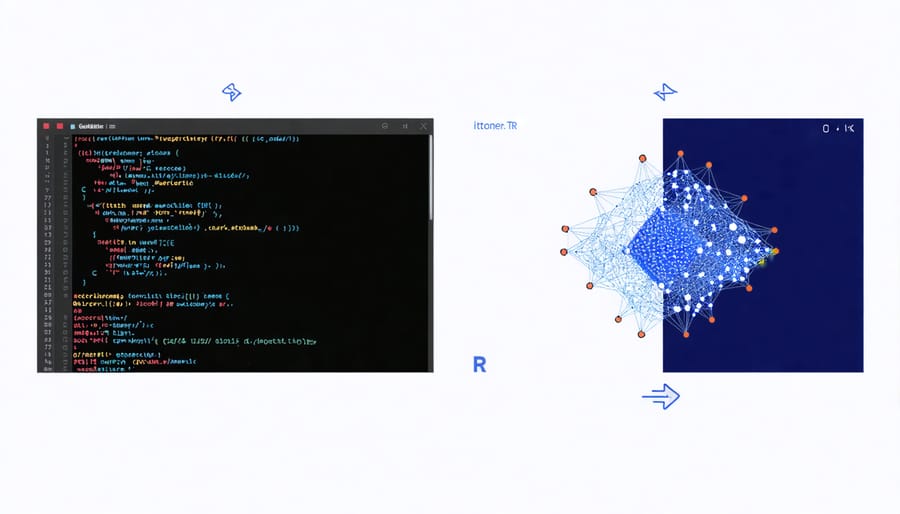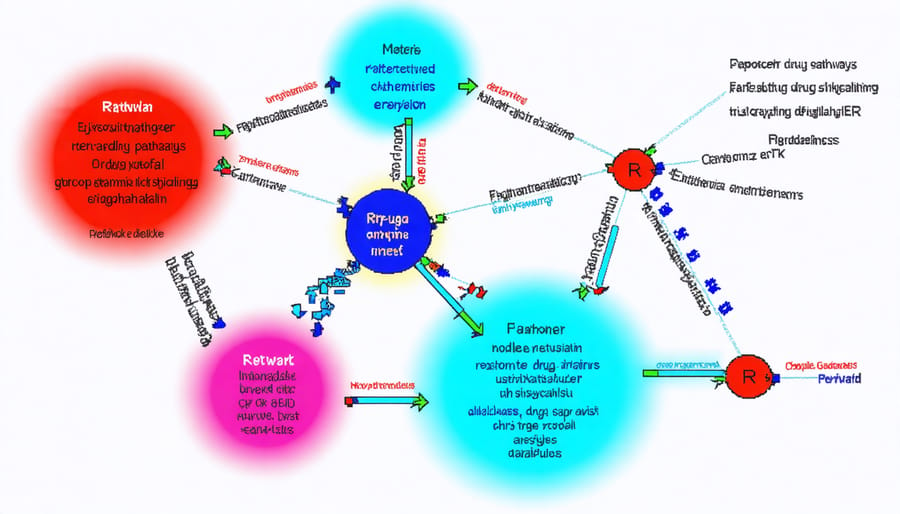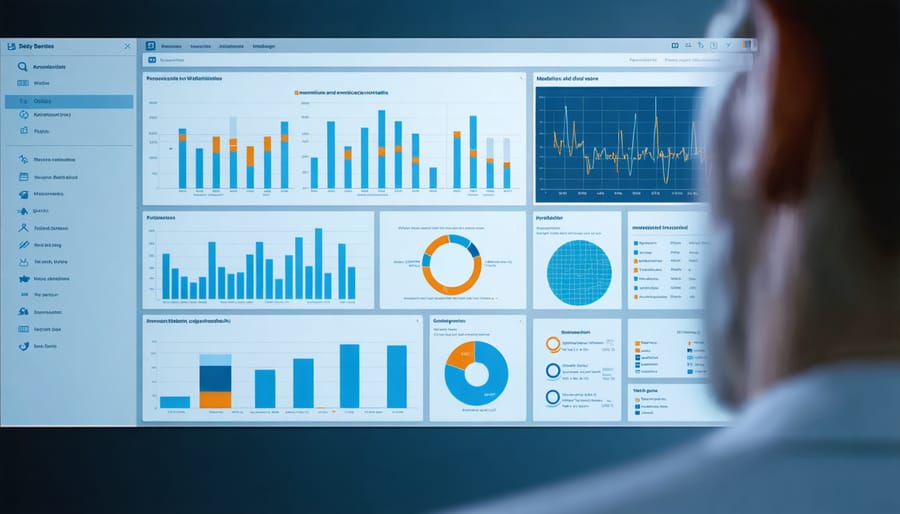R programming has revolutionized bioinformatics by making complex genomic analysis accessible to researchers across Alberta and beyond. This powerful statistical computing platform enables scientists to process vast amounts of biological data, from DNA sequencing to protein structure analysis, with remarkable efficiency. Whether you’re analyzing gene expression patterns or building predictive models for drug responses, R provides the essential tools and packages like Bioconductor that make advanced biotechnology research possible.
For healthcare professionals and researchers in our community, R’s application in bioinformatics represents more than just data analysis – it’s accelerating discoveries that directly impact patient care. By processing complex biological datasets, researchers can identify disease markers, develop personalized treatment approaches, and understand drug interactions more effectively. The combination of R’s statistical capabilities with specialized bioinformatics packages has created a framework where analyzing millions of data points becomes manageable and meaningful.
Modern bioinformatics research in Alberta increasingly relies on R because it’s free, open-source, and supported by a robust community of scientists who continuously develop new tools for biological data analysis. From visualizing complex genomic data to performing sophisticated statistical analyses, R has become an indispensable tool in the quest to understand human health and disease at the molecular level.
How R Programming Speeds Up Drug Development
Data Analysis Made Simple
R programming simplifies the complex world of biological data analysis, making it more accessible for researchers and healthcare professionals in Alberta. When working with large genomic datasets or clinical trial information, R provides powerful tools that help scientists uncover meaningful patterns and relationships. Much like how AI-powered drug discovery is revolutionizing medicine, R’s statistical capabilities allow researchers to process vast amounts of genetic information quickly and accurately.
Think of R as a Swiss Army knife for bioinformatics – it can handle everything from basic statistical tests to advanced genomic analyses. Researchers can easily create visual representations of their findings through charts and graphs, making complex biological concepts more understandable for everyone involved in healthcare decision-making.
What makes R particularly valuable is its open-source nature and extensive collection of specialized packages designed specifically for biological data analysis. These tools help local researchers track disease patterns, analyze treatment responses, and identify potential genetic markers for various health conditions affecting our community.
Visualizing Drug Interactions
R programming offers powerful tools for scientists to understand how drugs interact with proteins in our bodies, making it easier to develop more effective treatments. Using packages like Bio3D and ggplot2, researchers can create detailed 3D visualizations of how medications bind to specific proteins, much like seeing how a key fits into a lock.
Here in Alberta, this technology helps our local research teams at institutions like the University of Alberta and the Cross Cancer Institute develop targeted therapies for conditions common in our community, such as diabetes and heart disease. These visual tools allow scientists to predict which drugs might work best for different patients, moving us closer to personalized medicine.
The process involves analyzing large datasets of molecular structures and creating interactive models that researchers can rotate and examine from different angles. This helps them spot potential problems or opportunities for improving drug designs before costly clinical trials begin. For example, researchers can quickly identify if a proposed drug might have unwanted interactions with other proteins, potentially reducing side effects in future treatments.
By making complex molecular interactions easier to understand, R programming is helping accelerate drug discovery right here in our province.

Real-World Success Stories in Drug Research

Cancer Treatment Breakthroughs
R programming has revolutionized cancer drug development, making treatments more targeted and effective for Albertans. At the Cross Cancer Institute in Edmonton, researchers use R to analyze complex genetic data and identify potential drug targets. One notable success story involves using R-based algorithms to develop a breast cancer treatment that’s now helping patients across the province.
The power of R lies in its ability to process vast amounts of biological data quickly. For example, when developing new melanoma treatments, researchers used R to analyze thousands of patient samples, identifying specific genetic markers that respond best to certain medications. This approach, combined with nanotech applications in medicine, has led to more personalized treatment options.
Local scientists at the University of Alberta are using R to simulate drug interactions before costly laboratory testing begins. This process has cut drug development time by up to 40% and helped identify promising compounds for treating lung cancer, which affects many Albertans each year.
The software’s statistical capabilities have also improved clinical trial design, making it easier to track patient responses and adjust treatments accordingly. These advancements mean cancer patients in Alberta now have access to more effective, personalized treatment options with fewer side effects.
Heart Disease Research Advances
R programming has revolutionized how researchers in Alberta and worldwide study heart disease, leading to significant breakthroughs in cardiovascular medicine. Local research teams use R’s powerful statistical tools to analyze large patient datasets, helping identify early warning signs of heart problems and develop more effective treatments.
A notable advancement is the development of personalized risk assessment models. These R-based tools help healthcare providers in Alberta predict cardiovascular events with greater accuracy by considering multiple factors like lifestyle, genetic markers, and environmental influences specific to our region.
Data visualization capabilities in R have made it easier for medical professionals to communicate complex findings to patients. Instead of overwhelming charts, R creates clear, interactive displays that help people understand their heart health status and treatment options.
Recent projects have used R to study the effectiveness of various heart medications in different population groups. This has led to more targeted treatment approaches, particularly beneficial for Alberta’s diverse communities. Researchers have also used R to analyze patterns in emergency room visits related to heart conditions, helping hospitals better prepare for cardiac emergencies.
Machine learning applications in R are now helping predict patient outcomes and identify the most effective interventions. This technology has reduced diagnosis time and improved treatment success rates, making a real difference in patient care across the province.
The Future of Medicine Through Code
Personalized Medicine
R programming is revolutionizing how doctors approach patient care in Alberta by enabling truly personalized treatment plans. By analyzing vast amounts of patient data, including genetic information, medical history, and lifestyle factors, R helps healthcare providers make more informed decisions about individual treatments.
For example, local healthcare facilities use R to process genetic sequencing data, helping identify which medications might work best for specific patients based on their genetic makeup. This is particularly valuable when treating conditions like cancer, where different patients respond differently to various therapies.
Working alongside modern gene editing technologies, R helps doctors predict treatment outcomes and adjust dosages based on individual patient characteristics. The software can analyze patterns in patient responses to medications, helping healthcare providers fine-tune treatment plans and reduce adverse reactions.
In Alberta’s healthcare system, this means better outcomes for patients with chronic conditions like diabetes or heart disease, as treatment plans can be adjusted based on real-time data analysis. R’s ability to process complex biological data makes it an invaluable tool in developing targeted therapies that consider each patient’s unique genetic profile and medical history.

Faster Drug Development
R programming is revolutionizing the drug development process, significantly reducing the time it takes to bring new medications from lab to pharmacy. By analyzing vast amounts of biological data and patient information, R-powered tools are helping researchers identify promising drug candidates faster than ever before. This is particularly important for Albertans dealing with chronic conditions who are waiting for more effective treatment options.
The integration of R with modern personalized medicine approaches means that drug development can now be tailored to specific genetic profiles and population groups. For our local communities, this translates to medications that are more effective and have fewer side effects.
What used to take 10-15 years in traditional drug development can now potentially be accomplished in half that time. R’s statistical capabilities help researchers quickly identify patterns in clinical trial data, predict drug interactions, and optimize dosage recommendations. This acceleration in drug development doesn’t just save time and money – it means that potentially life-changing treatments could reach Albertans sooner, improving health outcomes across our province.
R programming has revolutionized healthcare and drug development, bringing powerful data analysis capabilities to researchers and medical professionals right here in Alberta and across the globe. By enabling scientists to process vast amounts of genetic data quickly and accurately, R has accelerated the discovery of new treatments and improved our understanding of diseases affecting our community.
The impact is particularly evident in personalized medicine, where R’s statistical tools help doctors tailor treatments to individual patients based on their genetic profiles. This means more effective treatments with fewer side effects for Albertans managing chronic conditions. Local research institutions have leveraged R to study diseases prevalent in our region, from diabetes to heart disease, contributing to better health outcomes for our neighbors.
In drug development, R has dramatically reduced the time and cost of bringing new medications to market. What once took decades can now be accomplished in years, thanks to R’s ability to analyze complex biological data and predict drug interactions. This efficiency means faster access to life-saving treatments for our community.
Looking ahead, R programming continues to evolve, incorporating machine learning and artificial intelligence to tackle even more complex health challenges. As our local healthcare providers and researchers embrace these tools, we can expect more innovative solutions and improved health outcomes for Albertans in the years to come. The future of healthcare is data-driven, and R programming stands at the forefront of this transformation.

